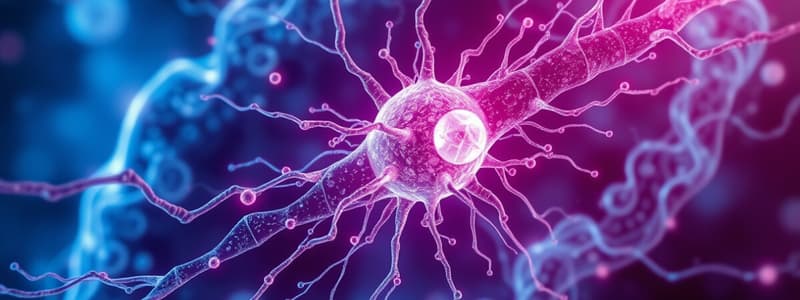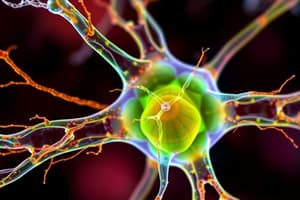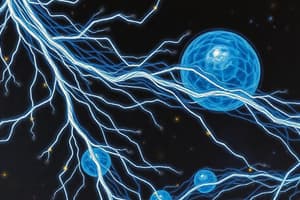Podcast
Questions and Answers
Tubulin primarily exists as a homodimer consisting of α- and β-tubulin.
Tubulin primarily exists as a homodimer consisting of α- and β-tubulin.
False (B)
Post-translational modifications of tubulin proteins decrease heterogeneity and have no effect on microtubule behavior.
Post-translational modifications of tubulin proteins decrease heterogeneity and have no effect on microtubule behavior.
False (B)
Mutations in TubB isoforms can lead to brain malformations due to their impact on microtubule dynamics.
Mutations in TubB isoforms can lead to brain malformations due to their impact on microtubule dynamics.
True (A)
Radial microtubule arrays are commonly found in non-dividing, differentiated cell types.
Radial microtubule arrays are commonly found in non-dividing, differentiated cell types.
Branched and bundled actin structures primarily generate compressive forces in cells.
Branched and bundled actin structures primarily generate compressive forces in cells.
Cortical networks of actin exert tension in a singular direction.
Cortical networks of actin exert tension in a singular direction.
Stress fibers consist of contractile bundles of actin filaments arranged in a parallel formation.
Stress fibers consist of contractile bundles of actin filaments arranged in a parallel formation.
The tubulin code influences microtubule behavior, dynamics, and interactions with other proteins.
The tubulin code influences microtubule behavior, dynamics, and interactions with other proteins.
Microtubule organization in tissue remodeling is uniform across all cell types.
Microtubule organization in tissue remodeling is uniform across all cell types.
GTP binding has no effect on the dynamics of microtubules.
GTP binding has no effect on the dynamics of microtubules.
Actin filaments are composed of a single polypeptide chain that forms a hollow structure.
Actin filaments are composed of a single polypeptide chain that forms a hollow structure.
Microtubules are primarily constructed from dimers of α- and γ-tubulin.
Microtubules are primarily constructed from dimers of α- and γ-tubulin.
Stress fibers are primarily responsible for generating tension in the cell, rather than providing structural rigidity.
Stress fibers are primarily responsible for generating tension in the cell, rather than providing structural rigidity.
The actin cortex allows cells to deform easily, making it less capable of withstanding tension.
The actin cortex allows cells to deform easily, making it less capable of withstanding tension.
Intermediate filaments provide mechanical strength and help reinforce cell shape but do not directly participate in motility.
Intermediate filaments provide mechanical strength and help reinforce cell shape but do not directly participate in motility.
The assembly of actin filaments is primarily dependent on GTP hydrolysis.
The assembly of actin filaments is primarily dependent on GTP hydrolysis.
Microtubules play a minimal role in cell shape changes during epithelial morphogenesis.
Microtubules play a minimal role in cell shape changes during epithelial morphogenesis.
The ARP2/3 complex is a crucial mediator for the assembly of microtubules.
The ARP2/3 complex is a crucial mediator for the assembly of microtubules.
Filopodia are broad and flat structures that primarily act to retract the cell during migration.
Filopodia are broad and flat structures that primarily act to retract the cell during migration.
Actin-myosin interactions are responsible for generating contractile forces during cytokinesis.
Actin-myosin interactions are responsible for generating contractile forces during cytokinesis.
Uropods are located at the leading edge of a migrating cell.
Uropods are located at the leading edge of a migrating cell.
Microtubules aid in cell motility through structures like lamellipodia and filopodia.
Microtubules aid in cell motility through structures like lamellipodia and filopodia.
Lamellipodia consist of densely packed actin filaments that form broad, sheet-like structures at the leading edge.
Lamellipodia consist of densely packed actin filaments that form broad, sheet-like structures at the leading edge.
Intermediate filaments help in positioning organelles by providing fixed fiber structures.
Intermediate filaments help in positioning organelles by providing fixed fiber structures.
Actin and myosin play no role in morphogenesis, as they are not involved in cell shape changes.
Actin and myosin play no role in morphogenesis, as they are not involved in cell shape changes.
The primary role of podosomes is to provide structural support to stationary cells.
The primary role of podosomes is to provide structural support to stationary cells.
Cortical tension directly influences processes such as cytokinesis and cell migration shape changes.
Cortical tension directly influences processes such as cytokinesis and cell migration shape changes.
Actinopathy can lead to the formation of various protrusions that affect cell motility.
Actinopathy can lead to the formation of various protrusions that affect cell motility.
Cellular polarity is established primarily through the signaling pathways Rac and Rho, which do not regulate cytoskeleton dynamics.
Cellular polarity is established primarily through the signaling pathways Rac and Rho, which do not regulate cytoskeleton dynamics.
Focal adhesions can form even when tension is absent, as they do not rely on integrin binding.
Focal adhesions can form even when tension is absent, as they do not rely on integrin binding.
Protrusion during cell migration involves leading edge polymerization of actin to create pushing forces.
Protrusion during cell migration involves leading edge polymerization of actin to create pushing forces.
Retraction is the process of introducing new adhesions at the rear of the cell to facilitate forward movement.
Retraction is the process of introducing new adhesions at the rear of the cell to facilitate forward movement.
Cellular polarity has no role in defining the front and back of a cell.
Cellular polarity has no role in defining the front and back of a cell.
Podosomes primarily function to increase surface area for absorption in epithelial cells.
Podosomes primarily function to increase surface area for absorption in epithelial cells.
Microvilli are supported by parallel bundles of actin filaments and aid in maintaining cell polarity.
Microvilli are supported by parallel bundles of actin filaments and aid in maintaining cell polarity.
The formation of lamellipodia is initiated by the Arp2/3 complex during actin nucleation.
The formation of lamellipodia is initiated by the Arp2/3 complex during actin nucleation.
Focal adhesions are generated primarily by the polymerization of microtubules.
Focal adhesions are generated primarily by the polymerization of microtubules.
In mesenchymal migration, cell body contraction occurs before the nucleation of actin.
In mesenchymal migration, cell body contraction occurs before the nucleation of actin.
Lamellipodia are formed as a response to external signaling pathways.
Lamellipodia are formed as a response to external signaling pathways.
The main role of protrusions in cells is to stabilize the cell shape and prevent migration.
The main role of protrusions in cells is to stabilize the cell shape and prevent migration.
Protease activity is decreased during the rearrangement of proteins in cellular protrusions.
Protease activity is decreased during the rearrangement of proteins in cellular protrusions.
Cellular protrusions only consist of actin filaments and do not involve microtubules.
Cellular protrusions only consist of actin filaments and do not involve microtubules.
Mature focal adhesions disassemble at the front of the cell to promote movement.
Mature focal adhesions disassemble at the front of the cell to promote movement.
Study Notes
Cytoskeleton Overview
- Comprises three main components: Microtubules, Actin filaments, and Intermediate filaments.
- Provides structure, shape, and support for cells, enabling movement, migration, and cell organization.
Structural Characteristics
- Actin Filaments: Composed of two helically twisted chains, involved in muscle contraction and cell division.
- Microtubules: Hollow tubes made of α- and β-tubulin dimers, anchoring at centrosomes, essential for cellular organization and mitotic spindle formation.
- Intermediate Filaments: Diverse in composition, thick fibers made of proteins like keratins, providing strength and structural support without inherent polarity.
Role in Cell Shape and Organization
- Actin Filaments: Maintain cell shape and provide mechanical support; crucial during cytokinesis and muscle contraction.
- Microtubules: Organize cell components, control organelle positioning, and facilitate vesicular transport.
- Intermediate Filaments: Provide tensile strength, reinforcing cell structure and enabling resilience under stress.
Cell Motility and Migration
- Actin Filaments: Central to motility, forming structures like lamellipodia and filopodia; actin-myosin interactions produce contractile forces.
- Microtubules: Facilitate vesicular transport, aid in centrosomal positioning, and form components of cilia and flagella for motility.
- Intermediate Filaments: Do not participate in motility directly but stabilize organelle positioning.
Assembly Mechanisms
- Actin Filaments: Assembly driven by ATP consumption; nucleation and polymerization lead to growth and branching.
- Microtubules: GTP-dependent growth; hydrolysis of GTP promotes disassembly, impacting dynamic stability.
- Intermediate Filaments: Assembly involves complex protein interactions but lacks clear nucleotide dependence.
Tubulin Isoforms and Variability
- Variability Sources: Multiple α- and β-tubulin isoforms lead to functional diversity; post-translational modifications increase microtubule heterogeneity.
- Impact of Mutations: Altered isoforms affect microtubule stability and dynamics, with implications for cellular function; tubulinopathies can result in malformations.
Actin Arrangements and Force Generation
- Branched and Bundled Actin: Critical for resisting compressive forces and exerting protrusive forces.
- Cortical Networks: Provide uniform tension across cells, maintaining integrity and shape.
- Stress Fibers: Arrangements facilitate rigidity and connect with focal adhesions, crucial in tension generation and cell movement.
Key Cellular Protrusions
- Uropod: Rear part of migrating cells, crucial for guiding movement and maintaining directionality.
- Filopodia: Sensory projections that explore the environment, aiding directional migration.
- Lamellipodia: Sheet-like extensions driving forward movement, essential for cell migration.
- Podosomes: Actin-rich structures involved in adhesion and matrix degradation, found in invasive cells.
- Microvilli: Enhance surface area for absorption in epithelial cells, maintaining cell polarity.
Steps in Cell Migration
- Signal Activation: External signals initiate migration pathways.
- Nucleation of Actin: Actin polymerization is facilitated by Arp2/3 complex to form protrusive structures.
- Cell Polarization: Orientation influences the direction of movement.
- Formation of Protrusions: Leading edges such as lamellipodia extend and push forward.
- Focal Adhesion Formation: Connects to the extracellular matrix, generating contractile forces for movement.
- Cell Body Contraction: Movement is driven from rear to front by contraction and retraction processes.
Interaction Between Cytoskeleton Components
- Forces of Migration: In embryogenesis, polarization defines the direction, protrusion starts movement through actin polymerization, adhesion secures the cells for push-off, and retraction releases connections for forward motion.
- Cytoskeletal Dynamics: Changes to cytoskeletal components and associated molecules significantly influence cell shape, motility, and overall migration capability.
Studying That Suits You
Use AI to generate personalized quizzes and flashcards to suit your learning preferences.
Related Documents
Description
This quiz explores the differences and similarities between actin filaments, microtubules, and intermediate filaments. It will cover their structures, roles in cell shape and motility, assembly mechanisms, and mediators. Dive into the fascinating world of the cytoskeleton and understand how these components contribute to cellular functionality.




